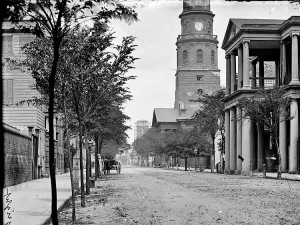St. Michael's Steeple

The gleaming Spire of St. Michael’s Episcopal Church stands as a great testimonial to Charleston’s ability to survive disaster. The belfry on the 1761 church was used for many years as a fire lookout. A “steepleman” was posted in the open arcaded area, and if he saw evidence of a fire, would go down the narrow stairs to the “ringing room” and pull eight strokes on a rope attached to the largest bell above. This 1900-pound bell could be heard throughout the old city, and firemen on the old “engine companies” were trained to listen for the signal. From almost any vantage point, they could have seen St. Michael’s steeple, and the steepleman’s next job was to climb back up to the arcade, light a lantern, and hang it on a pole pointing in the direction of the fire. This method was used until the city put up separate fire bell towers in the 1880’s as part of Charleston’s first municipal fire department.
S. Michael’s steeple was also used during wars as a military look-out, manned by local soldiers during the Revolution and War Between the States to observe besieging forces around Charleston. By 1863, Union troops on Morris Island were bombarding the city regularly with rifled cannons that could easily hit the glaring target that St. Michael;s made, so the city painted church and steeple a slate gray so that it would blend in with the horizon from a distance.
Since the bombardment in the 1860’s, the steeple survived direct hits during the earthquake of 1886, when it was supported with huge beams to prevent its collapse, and when a 1938 hurricane struck on ironically, St. Michael’s Day, Sept. 29th.
Posted on 04/18/2011 in Uncategorized